
Notwithstanding what I have said as to the unsociable nature of the Crow, I had frequent opportunities of
observing small parties passing over the park at Tregothnan to roost in the great woods of Talverne, ever
and anon uttering their hoarse croaking call.
Although large trees in parks and iuclosures are usually the places in which the Crow constructs its
nest, of sticks strongly cemented together with clay, and lined first with roots and then with quantities of
wool, fur of animals, and other soft materials to the extent of two or three inches in thickness, the bird
experiences no difficulty in constructing it of different materials in other situations, of which I find the following
remarkable instance in Mr. Hewitson’s interesting * Coloured Illustrations of the Eggs of British Birds,’
3rd edition, vol. i. p. 223:—“ In 1832 a pair of these birds took a singular fancy into their heads; deserting
the habits of their forefathers and the society of their species, they repaired to one of the Fern Islands
to breed, apparently thus subjecting themselves to very great inconvenience. Contrary to their usual
habits they built their nest upon the ground, there being no trees on the islands. It was of most curious
construction ; and instead of sticks (of which it is in other instances composed, and which the neighbourhood
would not supply), the outside was formed of small pieces of turf, neatly laid upon each other and formed
into a compact wall; the space within was lined with a quantity of wool, which was all brought from the
mainland, a distance of four or five miles.” . The bird will also just as readily avail itself of the ledge of
of a rock or any projection on a cliff-side.
Its food is much more varied than might he inferred from what has been said above, its omnivorous
appetite inducing it to devour worms, snails, crustaceans, portions of dead fish or other garbage thrown
up by the tide; neither does it object to the farmer’s beans and potatoes or the gardener’s walnuts and
fruits, provided its pilfering can be .carried on without a chance of detection. In its approach to the
field and the garden, it exhibits, much craft and caution; and the keeper, who is the Crow’s deadliest
enemy, has to exercise all his skill and cunning to circumvent this wary bird; a few eggs, however,
or a dead rabbit placed beside a hidden trap, are irresistible temptations and often lead him to
destruction. For the sake of showing this mode of capture I have in this instance gone a little o.ut
of my way, and represented in the accompanying Plate a bird in a difficulty from which he could never
extricate himself. Sympathy he may obtain from his partner, to whom he has probably been united from
the attainment of maturity; but assistance she cannot render him. If the Crow can be tempted to put
his toes on the trap his doom is sealed; as it also is when he partakes of the strychnined piece of flesh
which the keeper purposely lays for him.
The eggs are usually four or five in number, of a pale bluish green, spotted and speckled with two shades
of ash-colour and dove-brown ; but they vary much in the depth of the colouring, some being deeply and
others lightly tinted; occasionally they are light blue, unspotted, but marked here and there with uuder-
tints of grey. They are one inch and eight lines by one inch and two lilies in diameter.
The male feeds and spiritedly defends the female while sitting; and both bravely repel birds much larger
than themselves (such as the Raven, the Kite, and the Buzzard) which may appear to have any evil designs
upon their young.
Waterton states that the Carrion-Crow carries off eggs not in the bill, but on the point of it, after having
thrust the upper mandible through the shell; both Macgillivray and Thompson, however, give an instance
each in which, upon the bird being alarmed, the egg when found was still whole.
A number of interesting anecdotes respecting the cunning and predaceons habits of this bird will be
found in the various works on British Birds ; but I have probably said enough respecting a species so well
known to every one. I must not, however, omit to mention that, according to Mr. Hogg, it may be easily
tamed, and then becomes strongly attached to the person who rears it, but is apt to peck severely any one
else who attempts to meddle with it.
The sexes are alike in colour; but the female is somewhat smaller than her mate. The young are like
the adults, except that they have less of the metallic lustre on the upper surface.
In case ornithologists should desire to institute a comparison of the size of the European Crow with the
Crows of other countries, I append the careful admeasurements of a fine old male, taken early in
February, 1870:—
Total length 17a inches, bill 2 |, wing 11 7 , tail 7 \, tarsi 2$.
The figures are rather under the natural size. The flower is the common red poppy ( Paparer li/ioeas, Linn.).